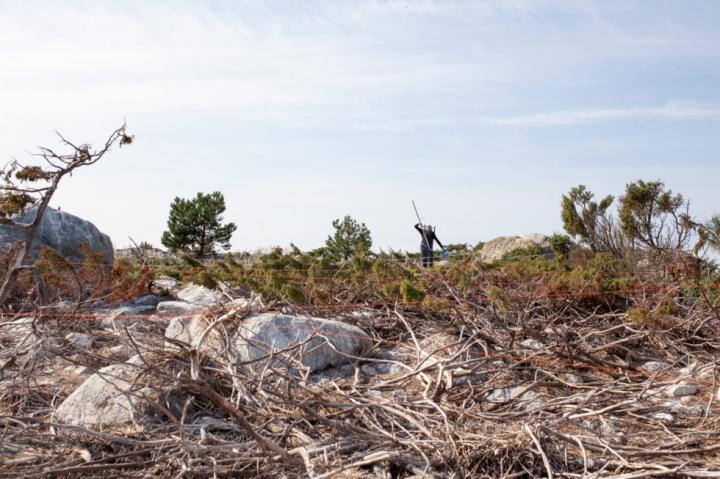
Credit: Picture: Luke/Lari Veneranta
The joint study of the Natural Resources Institute Finland (Luke) and University of Jyväskylä estimated the impact of cormorants breeding and living in Quark on perch populations and catches in the area. A large number of breeding cormorants in the important perch fishing and reproduction areas may reduce perch populations and catches especially in areas affected by breeding. On a larger spatial scale, the impact of cormorant predation is lower. The study was published in the ICES Journal of Marine Science in August 2020.
Since 2016, a large number of cormorants had breeding colonies in Quark. Their impact on perch populations was studied using Passive iIntegrated Transponder (PIT) tags in 2018, when 3,140 cormorant nests were calculated in the area. A total of 1,977 perch individuals were marked using small and invisible PIT tags placed under the skin.
“The PIT tags showed that a large number of breeding cormorants in a key perch fishing and reproduction area may reduce perch populations and catches locally. On a wider spatial scale, the impact of predation decreases. Overall, the large cormorant population in Quark may reduce the profitability of perch fishing, especially in the area affected by breeding colonies”, says Lari Veneranta, research scientist at the Natural Resources Institute Finland (Luke).
Some nine per cent of the total number of the tags placed were found from colonies. These results help to determine that, during the whole breeding and migration period, cormorants caught at most 20 to 33 per cent of the tagged perch individuals, if the fish consumption of young individuals is included and if it is assumed that cormorants remained in the same area after breeding.
“Based on literature, we estimated that roughly half of all perch individuals consumed by cormorants and all the tags placed ended up in colonies during the breeding period. The tags were recovered well, and according to our tests, some 90 per cent of the tags found from breeding colonies were discovered using detection equipment”, Veneranta says.
Cormorants were estimated to increase natural mortality in the tagged perch populations by seven to 26 percentage points. The growth rate of perch individuals affects how large a proportion of perch populations is caught by cormorants. The typical length of a perch individual eaten by a cormorant is 15 cm. On the basis of the determined age and growth of perch individuals, roughly half of perch individuals in the studied area remain small-sized, while the other half reach the fishing threshold size of 22 to 25 cm in three to four years. Small-sized individuals can be at risk of being caught by cormorants throughout their lives, while they are rarely at risk of being caught by fishermen.
In the 2,800 square-kilometre fisheries statistical rectangle surrounding the breeding colonies, the proportion of the biomass and production of perch individuals of more than two years consumed by cormorants was estimated to be roughly eight per cent, while other natural mortality accounted for 63 and fishing for 29 per cent. The impact of fish caught by cormorants migrating through the area was not included in the calculations.
The impact of cormorants on perch populations in Quark has been assessed in the long term
If perch populations decrease, cormorants will increasingly use other fish species. Other natural mortality will also decrease and the growth and reproduction rate of perch individuals may increase.
“These factors compensate for the decreasing impact of cormorants on perch populations, at least in part. The size of perch populations is mostly affected by environmental factors, such as the temperature during the first summer of young perch individuals”, says Outi Heikinheimo, visiting specialist at Luke.
The long-term impact of cormorants on perch catches in the Quark has been assessed on the basis of the results of the PIT tag study and other available data. The aim is to take into account any uncertainties associated with the background data and their impact on results.
If the number of cormorants and the density of two-year-old perch individuals remained at the 2018 level in the long term, perch catches would decrease by at most 32 to 67 per cent in the predation area of breeding cormorants, assuming that perch populations do not migrate, young cormorants catch their food in the same area in which they nest and cormorants remain in the same area until they migrate. When generalised over a broader area, statistical rectangle, perch catches would decrease by at most ten to 33 per cent.
“Estimates of fish catches, expanded from test results, have broad probability distributions, as initial data about perch population dynamics, regional distribution and movements comprises rough estimates at best. Nevertheless, these probability distributions offer the best available data from 2018 regarding the maximum impact of cormorant populations on perch populations and catches in Quark”, says Timo J. Marjomäki, lecturer in the Department of Biological and Environmental Science at the University of Jyväskylä.
###
Link to the study in ICES Journal of Marine Science in August 2020.
The study was conducted as part of the partnership programme between researchers and fishermen, coordinated by Luke and funded by the European Maritime and Fisheries Fund (EMFF). The programme’s partners include University of Jyväskylä, the Finnish Institute for Health and Welfare and Finland’s professional fishermen’s association.
Further information:
Lari Veneranta, research scientist, Luke, [email protected], tel. +358 29 532 7203
Timo J. Marjomäki, lecturer, Department of Biological and Environmental Science, University of Jyväskylä, [email protected], tel. +358 50 428 5274
Ari Leskelä, principal scientist, Luke, [email protected], tel. +358 29 532 7404
Media Contact
Timo Marjomäki
[email protected]
Original Source
https:/
Related Journal Article
http://dx.




